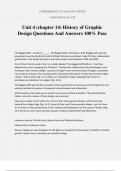©THEBRIGHT EXAM SOLUTIONS
11/06/2024 10:41 AM
Unit 4 (chapter 14) History of Graphic
Design Questions And Answers 100% Pass
The Beggarstaffs - answer✔______- The Beggarstaffs, otherwise J. & W. Beggarstaff, was the
pseudonym used by the British artists William Nicholson and James Pryde for their collaborative
partnership in the design of posters and other graphic work between 1894 and 1899.
One of them found a sack of corn in a stable labeled "the Beggarstaff Brothers," and they
adopted the name, dropping the "Brothers." During their collaboration they developed a new
technique, later named collage. Cut pieces of paper were moved around, changed, and pasted
into position on board. The resulting style of absolutely flat planes of color had sensitive edges
"drawn" with scissors (Fig. 14-1). Often, an incomplete image challenged the viewer to
participate and decipher the subject (Fig. 14-2).
The Beggarstaffs ignored the prevalent trend toward floral art nouveau as they forged this new
working method into posters of powerful colored shapes and silhouettes.
Unfortunately, their work was an artistic success but a financial disaster. They attracted few
clients, and only a dozen of their designs were printed.
They were unable to find clients for some of their more generic designs, which never got
beyond the collage stage (Fig. 14-3). Some of their most famous poster designs, such as those
for Sir Henry Irving's productions of Don Quixote and Robespierre at the Lyceum Theater (Figs.
14-4 and 14-5), were never printed, because Irving considered both bad likenesses.
sudanem used by 2 British artist (James Pryde and William Nicholson)
influenced by Toulouse-Lautrec
Pieces of paper on color background, left figure in complete for the viewer to decipher it (called
gestalt: humans have a tendency to complete things)
, ©THEBRIGHT EXAM SOLUTIONS
11/06/2024 10:41 AM
Two artists, James Pryde and William Nicholson, "The Beggarstaffs" developed a new visual
technique later called collage, in which paper is glued together to
Plakatstil - answer✔________- (Poster Style), which used reductive imagery and flat-color as
well as Sachplakat ('object poster') which restricted the image to simply the object being
advertised and the brand name
poster style made by Lucian Bernard
Sometimes used interchangeable with Sachplakte (object poster) doesn't have large, flat color
(still single object)
reductive imagery, flat color, restricted image to just object being advertised with the brand
name
A flat-color pictorial design style that maintains a balance between 2-D design structure and
imagery. It emerged in Germany early in the 20th century.
Swastika - answer✔Adopted in WWI as the symbol for the Nazi Party... represented the
German "master race"... Ludwig Hohlwein's posters conveyed these images all across the
nation.
Art deco - answer✔______- visual art and architecture design style that started out in France
just after WW1
Started in out in late 20s and flourished internationally in the 30s and 40s
Had characteristics of art nouveau and also embraced machine technology (emphasize on
geometric shape/forms (spheres, polygons, rectangles, trapezoids, zigzags, chevrons, sunburst
motifs) lavish ornamentation,
chrysler building spire: build in 1928-30
-symmetrical, laid out in aluminum, stainless steel, chrome, plastic)
A term coined by British art historian Bevis Hillier, it identifies with popular geometric works of
the 1920's and 1930's... it signifies a major aesthetic sensibility in graphics, architecture, and
, ©THEBRIGHT EXAM SOLUTIONS
11/06/2024 10:41 AM
product design during the decades between the two world wars... the influences of cubism, the
Bauhaus, and the Vienna Secession commingled with De Stijl and suprematism as well as a
penchant for Egyptian, Aztec, and Assyrian motifs, Streamlining, zigzag, moderne, and
decorative geometry... these attributes were used to express the modern era of the machine
while still satisfying a passion for decoration
Descended from Art Nouveau, this movement of the 1920s and 1930s sought to upgrade
industrial design in competition with "fine art" and to work new materials into decorative
patterns that could be either machined or handcrafted. Characterized by streamlined,
elongated, and symmetrical design.
The 1920's modernistic art style that captured modernistic simplification of forms, while using
machine age materials. (p. 482)
Armory Show - answer✔Moved from New York to Chicago... it was the first American exhibition
of modern art and it caused and uproar throughout the country... a New York Times headline
about the Armory show proclaimed "cubists and futurists make insanity pay"
1913 - The first art show in the U.S., organized by the Ashcan School. Was most Americans first
exposure to European Impressionist and Post-Impressionist art, and caused a modernist
revolution in American art.
James Pryde - answer✔Brothers-in-law James Pryde and William Nicholson decided to open an
advertising design studio in 1894... they adopted pseudonyms to protect their reputations as
artists... one of them found a sack of corn in a stable labeled "the Beggarstaff Brothers," and
adopted the name... they also developed a new technique, later named collage... forged this
new working method into posters of powerful colored shapes and silhouettes.
William Nicholson - answer✔Brothers-in-law James Pryde and William Nicholson decided to
open an advertising design studio in 1894... they adopted pseudonyms to protect their
reputations as artists... one of them found a sack of corn in a stable labeled "the Beggarstaff
Brothers," and adopted the name... they also developed a new technique, later named
collage... forged this new working method into posters of powerful colored shapes and
silhouettes.
Lucian Bernhard - answer✔Lucian Bernhard was influential in helping create the design style
known as Plakatstil (Poster Style), which used reductive imagery and flat-color as well as




